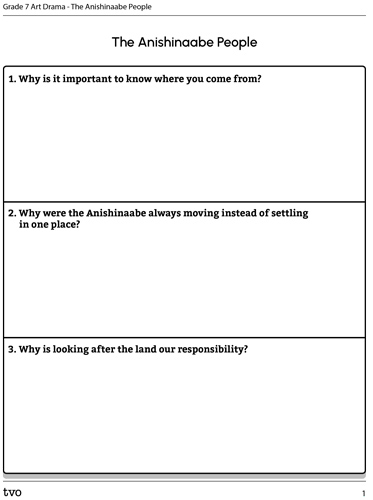Minds On
Warm up

Let’s begin with a breathing activity!
Don’t forget to do your safety check!
Warm Up
Breathing activity
Find a comfortable position. Focus your attention on one part of the body at a time.
How does that part of your body feel? If possible, take a deep breath and allow your lungs to expand.
Focus your attention on one part of your body. Allow that part to relax before moving on to the next. As you scan through your body, keep breathing deeply. Once you have completed the scan, take a moment to stretch.
Access the following audio recording “Breathing Activity" to follow this exercise.
Breathing Activity
Drama game
Imagine that you are a tree, beginning its life as a seed pod. Explore the following audio and practise visualizing, moving, or just exploring the process of growing through the seasons in your own way.
Access the following audio recording “Tree" to follow this exercise.
Tree
Student Success
Think-Pair-Share
Reflect on your experience using the following questions to guide you.
Share your thoughts with a partner, if possible.
- How did you feel when you grew out of the seed pod?
- What was it like when you first experienced the sun?
- How did it feel in role as the growing tree? Did you feel strong? Powerful? Vulnerable?
Note to teachers: See your teacher guide for collaboration tools, ideas and suggestions.
Let’s get started
Flashback/flashforward
When performing a character, actors may be asked to explore their character’s background, motivations, and consequences of their actions. One way to do this is in a flashback or flash forward.
A flashback or flash forward creates a context and demonstrates what leads up to a particular moment and/or what comes after that moment. This may take place seconds, minutes, days, or years before or after the moment being performed.
Performers in a scene are asked to improvise scenes which take place seconds, minutes, days, or years before or after a dramatic moment.
This technique helps to flesh out a moment or create the starting of a story.
Explore the following series of images.
Narration is a convention in which a speaker describes the action that is occurring in a drama. Instead of creating dialogue, a playwright could decide to tell the story through the use of narration.
Reflect back to the images you recently explored and consider the following questions:
- As a narrator, flashback and consider, what happened to the characters just before this moment?
- As a narrator, flashforward and consider, what might happen to the characters next?
You may share your flashback and flashforward scenes with a partner, create a detailed written or audio description.
Action
Get ready, get set…
In the Minds On section, you used the flashback and flashforward convention to explore character perspective. You narrated a story for the characters in each frame. By completing this activity, you were exploring multiple perspectives.
Perspective

In drama, we can explore multiple perspectives in role and as audience members.
To explore these perspectives, actors:
- have the opportunity to take on the role of a character with the perspectives of that character
- research their character
- work with the director and other cast and crew members to develop their character’s thoughts, feelings, and opinions
- create relationships with the other characters in the drama
As audience members, we:
- experience actors sharing their characters and the perspectives that come with those characters
- experience a variety of perspectives to get a whole sense of the drama
First-person and third-person perspective
Press the following tabs to learn more about first-person and third-person perspective.
In this case, the actor is a character in the story and the narrator who tells the drama story from their perspective. They share their personal thoughts, feelings, and experiences through dialogue with other characters and monologues to share information with the audience.
Word clues that signal a story is being told from first-person perspective are:
|
I |
me |
my |
|
we |
us |
our |
In this case, the actor is a narrator who is not a character in the drama story. The narrator makes observations about different characters in the drama story, and provides information that the audience might need (e.g. change in scene, special details about different characters etc.)
Word clues that signal a story is being told from third-person perspective are:
|
They |
them |
theirs |
|
she |
her |
hers |
|
he |
him |
his |
A narrator may also use the characters' names when they are telling the story.
Learning check!
Determine whether the following statements are in first- or third-person perspective.
Select the correct answer, then press ‘Check Answer’ to see how you did.
Perspective
In drama, we have the opportunity to explore multiple perspectives. Characters may share their thoughts in dialogue and share their internal thoughts with the audience through monologue.
Additionally, the narrator provides thoughts and opinions about all of the characters in a play or drama production. They provide the audience with multiple perspectives to explore.
What happens when we lose out on a valuable perspective?
When we only share a story from one perspective, or neglect to share the stories of those with varied perspectives, we get a biased or skewed understanding of those stories. We also fail to understand the communities whose stories we don’t share. In drama we have a responsibility to represent multiple perspectives and tell stories that include more than one worldview.
A valuable perspective
In the past, and still to this day, Indigenous perspective was one that was often missing from mainstream dramatic works. This lack of inclusion in dramatic performances on the main stages have left out a valuable perspective in the world of drama.
In the following video, Douglas Sinclair discusses the importance of understanding your own perspective by knowing where you come from.
He shares the Anishinaabe perspective on relationships and responsibilities to the land.
Access this video entitled “Our Relationships and Responsibilities to the Land.”
Use your understanding of the video to respond to the following questions.
- Why is it important to know where you come from?
- Why were the Anishinaabe always moving instead of settling in one place?
- Why is looking after the land our responsibility?
Complete the The Anishinaabe People activity in your notebook or using the following fillable and printable document. You can also use another method of your choice to record your ideas.
Consider adding your work to your drama portfolio.
The Anishinaabe People
Press ‘Let’s Check’ to access possible answers.
Possible Answers
- We need to know where we come from to understand who we are and what our connection is to the land. It gives us more of an understanding of our community and their values, traditions, and worldviews.
- The Anishinaabe were always moving so that they could grow and harvest crops. They were connected to the land, so they were aware of what was available to them.
- Our job is to look after this land and protect it because it doesn’t belong to us but we were left to protect it. We are the ones who interact with it.
Did You Know?
Who are the Anishinaabe peoples?
The Anishinaabe means the “people from whence lowered” or “original person” and includes the Odawa, Chippewa, Ojibway and Saulteaux, Oji-Cree, Mississaugas, Algonquin, Nipissing, and Potawatomi nations. These nations share common histories, languages and cultural values. Anishinaabe territory spans the Great Lakes region and what is now referred to as northern Ontario, western Quebec and Manitoba and Saskatchewan and into the Northern United States. The Ojibway (Chippewas), Odawa and Potawatomi Nations formed the Three Fires Confederacy over 1000 years ago and it still remains today.
As we work towards Truth and Reconciliation, information about lands and territories is constantly being updated. This map was created using information available as of March 2022 from The Canadian Encyclopedia.

Map of Anishinaabe traditional territory that spans the Great Lakes region and what is now referred to as northern Ontario, western Québec, Manitoba, Saskatchewan, and the northern United States.
Exploring our roots
Douglas Sinclair discussed the importance of knowing where we came from. In order to understand a person’s perspective, an understanding of their worldview, traditions, and values are important.
What do you know about where you come from?
Explore the following questions. Check the questions that you are able to answer. If you do not know, is there someone who could help you learn this information?
What do I know about where I came from?

If possible, share what you know about where you came from with a partner. In this way, we are sharing our perspectives, which include our knowledge and understanding of our traditions, values, and worldviews.
Pause and Reflect
Interview

If you could interview your ancestors, what questions would you ask them? What information would you want to know?
Record your ideas using a method of your choice.
Go!
Imagine you are a playwright, and you are going to be creating an original short story that involves the message of being responsible for the land, or another issue that is important to you. You will be sharing your perspective on this issue in your short story.
- How might knowing where you come from help shape your perspective about this story?
- How might knowing other people’s perspectives help shape your story?
- What are a few ideas that could help shape your perspective in the form of a story?
Press ‘Let’s Check’ to access a possible answer.
What if you need some support to shape your story?
Memory scan: Your memory or idea
What memories come to mind when you think of your connection to the land or an issue that is important to you?
You could also create an idea of how you would like to connect to the land in the future.
The drama technique called a memory scan can help to identify important parts of a memory. It can be used to help you visualize or consider your idea as well.
Consider the following questions to complete a memory scan:
- What is important in your memory?
- What were the specific details around you?
- What were the personalities of the people or person?
- Did anyone speak or communicate in another way in your memory?
- Is there a special focus in your memory on a real object (e.g., a painting, a sofa, etc.)?
Record your ideas using a method of your choice. Consider adding your work to your portfolio.
Creating your story
Step 1:
Decide if you would like to tell your story in first-person perspective, such as a dialogue or a monologue or a narrated story in third-person perspective that includes characters.
Check what option your story will be in.
My story will be in…
A monologue is a long speech by one character in a drama, intended to provide insight into the character.
Explore this video entitled “Monologue” to learn more about how actors use monologue to communicate their ideas and emotions to the audience.
Narration is a convention in which a speaker describes the action that is occurring in a drama. Instead of creating dialogue, a playwright could decide to tell the story through the use of narration.
Access this audio recording entitled “Narration of The Wasps, the Bees and the Hornet" to examine this narration.
Narration of The Wasps, the Bees and the Hornet
Step 2:
Decide if you would like this to involve only one character (your perspective) or more than one perspective.
Check what applies to your story.
My story will have…
Step 3:
This story will take place in one moment in time. Could you use flashback or flash forward to help build more context for your story? Revisit the Minds On section to explore these concepts once again.
Check what will apply to your story.
My story will include…
Step 4:
Begin to shape your story. Record your story using a method of your choice.
Consider adding your work to your drama portfolio.
Consolidation
Putting it all together

When you are ready, share your story with a partner, if possible, or record it to share at another time. You can also practise sharing your story aloud independently as well.
Reflection
- How did it feel creating a story that included your own perspective about this issue?
- Why does knowing about your past help you understand your own perspective?
- How does knowing multiple perspectives help understand a story as a whole?
Record your ideas using a method of your choice. Consider adding your work to your drama portfolio.
Portfolio
Journal reflection
Reflect on the learning tasks. This reflection is a space for you to express your feelings, ask questions about what you have just done, and connect thoughts together with specific activities or exercises.
Use 2-4 of the journal prompts from the Reflection Starters list and create a written, audio, or video reflection.
|
Prompts to Start a Reflection on Drama Class Note: The following prompts begin an entire thought and can be used to develop your thoughts and ideas. Note: Try to utilize two to four of the prompts provided. If there is something else you wish to share, continue to build on your ideas. Note: Explore your thoughts and feelings with direct reference to what you learned and explored within the lesson. When I did (Blank), it reminded me of… I really liked it when I did(Blank), because… I really want to know more about (Blank), because… I’m really happy about (Blank), because… If I were to sum up my experience in this lesson in one word it would be (Blank), because… When I think about what I accomplished in this task, I think about… When I learned about (Blank), it made me feel (Blank), because… |
Press the ‘Activity’ button to access Reflection Starters.
As you read the following descriptions, select the one that best describes your current understanding of the learning in this activity. Press the corresponding button once you have made your choice.
I feel…
Now, expand on your ideas by recording your thoughts using a voice recorder, speech-to-text, or writing tool.
When you review your notes on this learning activity later, reflect on whether you would select a different description based on your further review of the material in this learning activity.




